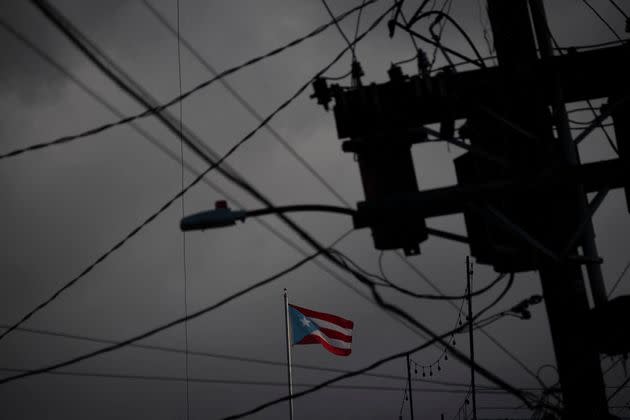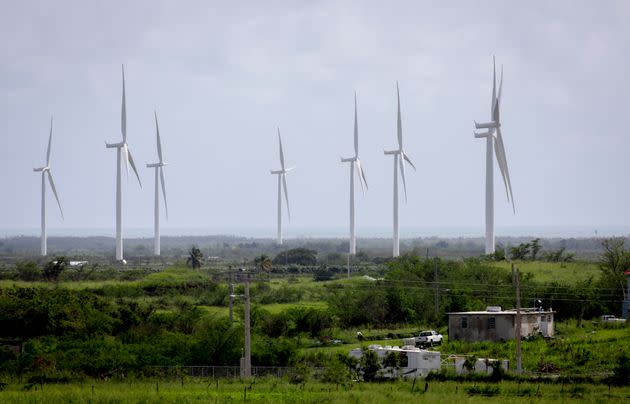Dangerous Heat Wave Tests Puerto Ricans’ Ability To Survive The Latest Power Outages
This week marks a grim milestone in Puerto Rico’s weather record: For the first time, virtually every inch of the U.S. Caribbean territory’s 311-mile coastline is roasting in temperatures that feel like 114 degrees Fahrenheit. Federal forecasters say heat exhaustion or stroke are “likely with prolonged exposure.”
For Gloricela Santiago, 59, staying cool these nights means sleeping outside on her balcony, breathing in the fumes of neighbors’ generators roaring through sunrise.
That’s because Santa Isabel, the seaside town where Santiago lives and works as a technician at a public housing complex, is one of three municipalities on Puerto Rico’s southern shore facing power outages that could last for seven weeks. Experts say workers can restore electricity in a matter of days, but the private utility that now controls Puerto Rico’s power system would need to use its own money rather than federal dollars.
“It is horrible. The heat is terrible. People cannot sleep and no longer have the budget to buy food,” Santiago said in Spanish, speaking over text message Monday night to save battery on her phone. “This is a crisis.”

America’s most populous unincorporated territory hasn’t had steady electricity since Hurricane Maria laid waste to the aging power grid in September 2017. The storm triggered an 11-month blackout ― the second-longest in modern history, leaving thousands to die without refrigerated medicine or filtered water.
The territory’s government hired private companies from the U.S. to run the state-owned utility’s power plants and distribution system. But a secretive bidding process yielded a contract that virtually guaranteed profits regardless of service quality. Nearly seven years after the hurricane, blackouts plague Puerto Ricans across the territory every week, if not daily, and rates keep going up.
“The bill gets higher every month,” Santiago said.
Last month, it was $80, even though she said, “I’m never at home. I’m always at work or church.”
It’s the kind of squeeze few Americans living in the states can imagine. Puerto Rico has worse poverty than the poorest U.S. state, yet pays some of the highest electricity rates in the entire country.
LUMA Energy, the joint venture between two Texas and Canadian energy companies that took over electricity sales three years ago, has repeatedly ratcheted up rates to pay for whatever parts of the grid reconstruction the billions of federal dollars don’t already cover. But service has seen little improvement. Puerto Ricans who can afford generators, solar panels or batteries buy them, yet those units are expensive to purchase and fuel, and the routine power surges frequently destroy batteries or appliances.
Thanks to a long-standing federal law that prevents Puerto Rico from importing goods from anywhere but the U.S., groceries can cost nearly a quarter more than the average in the States. The lack of cheaply available fresh produce has created a heavy reliance on processed foods, increasing the rates of diseases such as diabetes. With such unstable electricity, Puerto Ricans who try to buy more healthful, fresh foods risk wasting money when the latest outage leaves dairy or fruit to spoil in the Caribbean heat without refrigeration.
If that wasn’t enough, the bankruptcy courts handling the mammoth debt Puerto Rico’s utility accrued before the storm want to add a surcharge to every ratepayer’s bill for the next three decades to pay off what critics call the Wall Street equivalent of loan sharks.
A broad coalition of activists and business groups opposed the rate hike last year. Negotiations over how to restructure the Puerto Rico Electric Power Authority’s outstanding $9 billion in bond debt are ongoing, with recent proposals appearing to yield some progress.
In the meantime, however, system problems that might take a few hours or days to fix in the U.S. cause ongoing disasters in Puerto Rico.

Last week, a transformer blew out at one of LUMA’s substations on the south coast, a region already beset by deadly pollution from the territory’s largest coal-fired power plant and water shortages linked to overuse by a nearby cluster of agrichemical industrial facilities.
In response, LUMA instituted a schedule of rolling blackouts in the area, cutting off service every day for eight hours at a time in Santa Isabel and the neighboring towns of Coamo and Aibonito. With the U.S. facing a nationwide transformer shortage, LUMA said repairs could take five to seven weeks, effectively cutting off electricity for much of the day during what is forecast to be a particularly hot summer. The mayors of the towns called the wait time “unacceptable.”
Before Hurricane Maria, five transmission lines connected the substation in Santa Isabel to the power system directly to the east to the industrial town of Guayama, with one serving as the primary conduit and the other four providing backup. After the storm, the area around Santa Isabel became a closed-loop system, meaning losing a transformer causes major problems.
Erecting poles and stringing insulated power lines to reconnect the substation to Guayama would take five to six days, according to Rafael Machado, the retired southern regional director in charge of transmission at PREPA who happens to live in Santa Isabel. Doing so, however, would require LUMA to spend its own money now rather than wait for federal funds to come through for an already planned project nearby.
“For as bad as it was, PREPA was a service agency,” Machado said of the state-owned utility that ran the electrical system until 2021. “LUMA is a business.”
If LUMA “can put less money into the operations of the system, that money is going to go back to their pockets and their shareholders,” he said.
I can handle this, but there’s a lot of people who don’t have a generator in their house, and don’t have family to help them out. It is crazy. It is fucked up.Rafael Machado, retired utility worker whose town lost power
The cost of waiting for federal dollars to come through is borne by “the 80-year-olds, even 90-year-olds, and the kids 10 years and under who have been suffering this,” said Machado, who retired in 2014.
“I can handle this, but there’s a lot of people who don’t have a generator in their house, and don’t have family to help them out,” he said. “It is crazy. It is fucked up.”
LUMA did not respond to questions emailed Monday.
An official from the bankrupt government utility whose services LUMA privatized said fixing the substation should take no longer than two weeks but admitted he has no power over the company’s operations.
Puerto Rico Gov. Pedro Pierluisi’s office said LUMA is taking “short term works” to restore service in the southern towns, including “increasing capacity on one of the electric lines” and installing a portable generator.
“The permanent works to address the cause of the issue include replacing a transformer unit are ongoing and will still take additional time to be completed as this includes a complex transportation among other specialized works,” Francisco Berríos, the governor’s assistant chief of staff for energy affairs, told HuffPost in an emailed statement. “As the works to modernize the electric system continue to accelerate, we are requiring LUMA to improve their performance during this type of emergency situations where customers suffer interruptions.”
Last June, just days after LUMA celebrated its second anniversary as Puerto Rico’s new private power seller, a record-breaking heat wave sent thermometers soaring to 125 degrees Fahrenheit. The still-tattered grid heaved under demand for air conditioning, triggering a blackout that saw more than 100,000 lose power.
The prolonged blackouts over the past year cast doubt over LUMA’s capacity to quickly restore power after the next major hurricane. Combined with the effects of human-caused climate change, the regular El Niño climate patterns that intensified heating in the Caribbean Sea this year are expected to drive a fierce hurricane season in the Atlantic. The National Oceanic and Atmospheric Administration predicted with 85% certainty that this season will be “above normal” for hurricanes, with as many as 25 storms strong enough to earn names.
Santiago feels helpless ― and scared. She cannot afford a generator, so she charges her phone in her car or at the emergency room in nearby Salinas. A diabetic, she said her body reacts worse to heat than someone with naturally regulated insulin. When she gets dehydrated, she said, “It’s twice as bad.”
When electricity is out, the water pumps stop working, so she’s dependent on bottled water. But “no one brings water,” so she’s on her own to purchase that, too. Her one reprieve, she said, comes from going to the shopping mall ― not to buy anything, just to cool down with the retailers’ air conditioning.
“There is no word for it,” she said. “You almost feel like you are going to faint.”
Hours after this article initially published, equipment exploded at a San Juan electrical facility and left as many as 186,000 without electricity, El Vocero reported, showing photos of black smoke billowing from the disabled plant. By about 9 p.m. EDT, more than 40,000 households across the densely populated capital region remained cut off from the grid.
This article was updated to include details of the San Juan blackout.
Related...
Wall Street 'Vultures' Want Puerto Ricans To Pay Even More For Electricity That Doesn't Work
As Puerto Rico’s Privatized Power Grid Collapses, Its Owner Eyes A Bigger Payday
The Battle Over The Last Piece Of Puerto Rico That Wasn’t For Sale
On Puerto Rico’s 'Forgotten Island,' Tesla's Busted Solar Panels Tell A Cautionary Tale

 Yahoo News
Yahoo News 